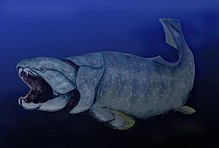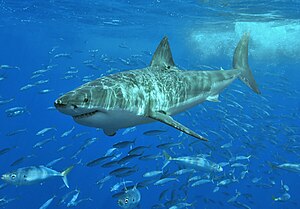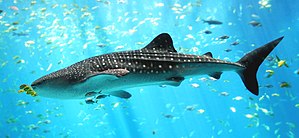Fish Immune system
Fish
Immune system
Types of immune organs vary between different types of fish.[27] In the jawless fish (lampreys and hagfishes), true lymphoid organs are absent. Instead, these fish rely on regions of lymphoid tissue within other organs to produce their immune cells. For example, erythrocytes, macrophages and plasma cells are produced in the anterior kidney (or pronephros) and some areas of the gut (where granulocytes mature) resemble primitive bone marrow in hagfish. Cartilaginous fish (sharks and rays) have a more advanced immune system than the jawless fish. They have three specialized organs that are unique to chondrichthyes; the epigonal organs (lymphoid tissue similar to bone marrow of mammals) that surround the gonads, the Leydig's organ within the walls of their esophagus, and a spiral valve in their intestine. All these organs house typical immune cells (granulocytes, lymphocytes and plasma cells). They also possess an identifiable thymus and a well-developed spleen (their most important immune organ) where various lymphocytes, plasma cells and macrophages develop and are stored. Chondrostean fish (sturgeons, paddlefish and birchirs) possess a major site for the production of granulocytes within a mass that is associated with the meninges (membranes surrounding the central nervous system) and their heart is frequently covered with tissue that contains lymphocytes, reticular cells and a small number of macrophages. The chondrostean kidney is an important hemopoietic organ; where erythrocytes, granulocytes, lymphocytes and macrophages develop. Like chondrostean fish, the major immune tissues of bony fish (or teleostei) include the kidney (especially the anterior kidney), where many different immune cells are housed.[28] In addition, teleost fish possess a thymus, spleen and scattered immune areas within mucosal tissues (e.g. in the skin, gills, gut and gonads). Much like the mammalian immune system, teleost erythrocytes, neutrophils and granulocytes are believed to reside in the spleen whereas lymphocytes are the major cell type found in the thymus.[29][30] Recently, a lymphatic system similar to that described in mammals was described in one species of teleost fish, the zebrafish. Although not confirmed as yet, this system presumably will be where naive (unstimulated) T cells will accumulate while waiting to encounter an antigen.[31]
Evolution
The early fossil record on fish is not very clear. It became a dominant form of sea life and eventually branched to create land vertebrates.[citation needed]
The proliferation was apparently due to the formation of the hinged jaw because jawless fish left very few descendants.[33] Lampreys may be a rough representative of pre-jawed fish. The first jaws are found in Placodermi fossils. It is unclear if the advantage of a hinged jaw is greater biting force, respiratory-related, or a combination.
Some speculate that fish may have evolved from a creature similar to a coral-like Sea squirt, whose larvae resemble primitive fish in some key ways. The first ancestors of fish may have kept the larval form into adulthood (as some sea squirts do today), although maybe the reverse of this is case. Candidates for early fish include Agnatha such as Haikouichthys, Myllokunmingia, Pikaia, and Conodonts.
Homeothermy
Although most fish are exclusively aquatic and ectothermic, there are exceptions to both cases.
Fish from a number of different groups have evolved the capacity to live out of the water for extended periods of time. Of these amphibious fish, some such as the mudskipper can live and move about on land for up to several days.
Also, certain species of fish maintain elevated body temperatures to varying degrees. Endothermic teleosts (bony fishes) are all in the suborder Scombroidei and include the billfishes, tunas, and one species of "primitive" mackerel (Gasterochisma melampus). All sharks in the family Lamnidae – shortfin mako, long fin mako, white, porbeagle, and salmon shark – are known to have the capacity for endothermy, and evidence suggests the trait exists in family Alopiidae (thresher sharks). The degree of endothermy varies from the billfish, which warm only their eyes and brain, to bluefin tuna and porbeagle sharks who maintain body temperatures elevated in excess of 20 °C above ambient water temperatures. See also gigantothermy. Endothermy, though metabolically costly, is thought to provide advantages such as increased contractile force of muscles, higher rates of central nervous system processing, and higher rates of digestion.
Diseases
Like other animals, fish can suffer from a wide variety of diseases and parasites. To prevent disease they have a variety of non-specific defences and specific defences. Non-specific defences include the skin and scales, as well as the mucus layer secreted by the epidermis that traps microorganisms and inhibits their growth. Should pathogens breach these defences, fish can develop an inflammatory response that increases the flow of blood to the infected region and delivers the white blood cells that will attempt to destroy the pathogens. Specific defences are specialised responses to particular pathogens recognised by the fish's body, in other words, an immune response.[34] In recent years, vaccines have become widely used in aquaculture and also with ornamental fish, for example the vaccines for furunculosis in farmed salmon and koi herpes virus in koi.[35][36]
Some fish will also take advantage of cleaner fish for removal of external parasites. The best known of these are the Bluestreak cleaner wrasses of the genus Labroides found on coral reefs in the Indian Ocean and Pacific Ocean. These small fish maintain so-called "cleaning stations" where other fish, known as hosts, will congregate and perform specific movements to attract the attention of the cleaner fish.[37] Cleaning behaviours have been observed in a number of other fish groups, including an interesting case between two cichlids of the same genus, Etroplus maculatus, the cleaner fish, and the much larger Etroplus suratensis, the host.[38]
Importance to humans
Economic importance
Recreation
Conservation
As of 2006, the IUCN Red List describes 1,173 species of fish as being threatened with extinction.[39] Included on this list are species such as Atlantic cod,[40] Devil's Hole pupfish,[41] coelacanths,[42] and great white sharks.[43] Because fish live underwater they are much more difficult to study than terrestrial animals and plants, and information about fish populations is often lacking. However, freshwater fish seem particularly threatened because they often live in relatively small areas. For example, the Devil's Hole pupfish occupies only a single 3 m by 6 m pool.[44]
Overfishing
In the case of edible fishes such as cod and tuna a major threat is overfishing.[45][46] Where overfishing persists, it eventually causes the collapse of the fish population (known as a "stock") because the population cannot breed fast enough to replace the individuals removed by fishing. One well-studied example of the collapse of a fishery is the Pacific sardine Sadinops sagax caerulues fishery off the coast of California. From a peak in 1937 of 790,000 tonnes the amount of fish landed steadily declined to a mere 24,000 tonnes in 1968, at which point the fishery stopped as no longer economically viable. Such commercial extinction does not mean that the fish itself goes extinct, merely that it can no longer sustain a profitable fishery.[47] The main tension between fisheries science and the fishing industry is the need to balance conservation with preserving the livelihoods of fishermen. In places such as Scotland, Newfoundland, and Alaska the fishing industry is a major employer, so governments have a vested interest in finding a balance between conserving fish stocks while maintaining an economic level of commercial fishing.[48][49] On the other hand, scientists and conservations push for increasingly stringent protection for fish stocks, warning that many stocks could be wiped out within fifty years.[50][51]
Habitat destruction
- See also: Environmental effects of fishing
A key stress on both freshwater and marine ecosystems is habitat degradation including water pollution, the building of dams, removal of water for use by humans, and the introduction of exotic species.[52] An example of a fish that has become endangered because of habitat change is the pallid sturgeon, a North American freshwater fish that living in rivers that have all been changed by human activity in a variety of different ways.[53]
Exotic species
Introduction of exotic species has occurred in a variety of places and for many different reasons. One of the best studied (and most severe) examples was the introduction of Nile perch into Lake Victoria. Since the 1960s the Nile perch gradually exterminated the 500 species of cichlid fishes found only in this lake and nowhere else. Some species survive now only in captive breeding programmes, but others are probably extinct.[54] Carp, snakeheads,[55] tilapia, European perch, brown trout, rainbow trout, and sea lampreys are other examples of fish that have caused problems by being introduced into alien environments.
Aquarium collecting
上一篇:Fish Definition
下一篇:Fish Culture


